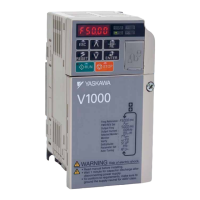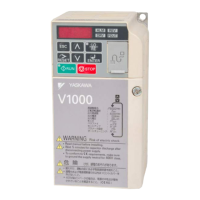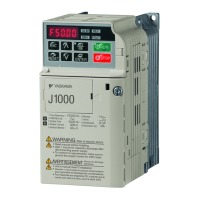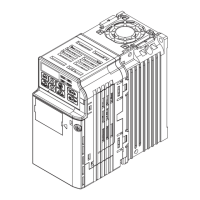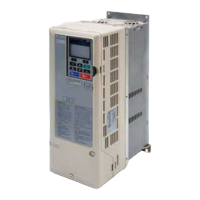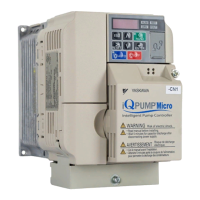Receiving
1
1.3 Features and Advantages of Control Methods
YASKAWA SIEPC71061753C GA500 Technical Manual 25
Control Method Selection
Open Loop Vector
(OLV)
Notes
Controlled Motor Induction Motor -
Starting Torque 150% / 1 Hz
*1
This is the motor torque that the drive can supply at low speed during
start-up and the related output frequency (rotation speed).
You must think about drive capacity when a large quantity of torque is
necessary at low speed.
Auto-Tuning
*2
Rotational, Stationary, and Line-to-Line Resistance Automatically tunes electrical motor parameters.
Torque Limits
*2
Yes
Controls maximum motor torque to prevent damage to machines and
loads.
Speed Search
*2
Yes
Immediately estimates (or detects) motor speed and direction when
coasting to a stop to quickly start-up the drive without stopping the motor.
Automatic Energy-saving Control
*2
Yes
Automatically adjusts the voltage that the drive applies to the motor to
maximize motor efficiency for small and large loads.
High Slip Braking (HSB) Activate No
Increases motor loss to let the motor decelerate faster than usual without a
braking resistor. Motor characteristics have an effect on this function.
Feed Forward Control No
Compensates effects of the system inertia to increase the speed precision
when the load changes.
KEB Ride-Thru Function
*2
Yes
Quickly and safely stops the motor during power loss and automatically
starts operation at the previous speed when the drive applies power again
without coasting the motor.
Overexcitation Deceleration
*2
Yes
Sets the V/f higher than the setting value during deceleration to increase
motor loss and decrease deceleration time.
Overvoltage Suppression Function
*2 *3
Yes Adjusts speed during regeneration to prevent overvoltage.
*1 Select the drive capacity accordingly.
*2 Note these points when you use this function:
• When you can decouple the motor and machine for a test run, use Rotational Auto-Tuning. You must make adjustments to the
control in the range where there is no vibration in the machine after Rotational Auto-Tuning.
• For vector control, use a 1:1 drive to motor ratio. You cannot use vector control when more than one motor is connected to one
drive. Select a drive capacity so that the motor rated current is 50% to 100% of the drive rated current. If the carrier frequency is
too high, the drive rated current is derated.
• Motor loss increases during overexcitation braking and high-slip braking. Use a maximum braking frequency of 5% ED and a
maximum braking time of 90 seconds. After you start high-slip braking, you cannot restart the motor until it stops. Use
overexcitation braking to decelerate over a shorter time at a pre-determined speed.
• Acceleration and deceleration have priority over torque limits in Open Loop Vector Control during acceleration and deceleration
(soft start changes). The drive will not operate until the speed is at the minimum frequency or the reverse direction of motor
rotation when the motor speed decreases because of torque limits during constant speed control. Set L7-07 = 1 [Torque Limit
during Accel/Decel = Proportional & Integral control] to enable torque limits during acceleration/deceleration (for winding
applications).
*3 Do not use this function with hoist application.
Table 1.7 Features and Advantages of OLV/PM, AOLV/PM, and EZOLV Control
Control Method
Selection
PM Open Loop Vector
Control
(OLV/PM)
PM Advanced Open Loop
Vector
(AOLV/PM)
EZ Open Loop Vector Control
(EZOLV)
Notes
Controlled Motor PM motor
Induction Motors/PM Motors/
SynRM (Synchronous
Reluctance Motors)
-
Parameter Settings A1-02 = 5 A1-02 = 6 A1-02 = 8 -
Basic Control
PM Open Loop Vector Control (no
speed controller)
PM Open Loop Current Vector
Control (with speed controller)
Open Loop Current Vector
Control
-
Main Applications
• General-purpose variable speed
control for PM motors
• Applications in which a high
level of responsiveness and
accurate speed control are not
necessary.
• General-purpose variable speed
control for IPM motors
• Applications in which high-
precision speed control and
torque limits are necessary.
Low-speed torque applications
Example: Fans and pumps
-
Maximum Output
Frequency
590 Hz 270 Hz 120 Hz -
Speed Control Range 1:10
1:10
1:100
*1 *2 *3
1:10
This is the range of variable control.
When you connect and operate motors in
this mode, think about the increase in
motor temperature.
Starting Torque 100% / 5% speed
100% / 5% speed
100% / 0 min
-1
*1
100% / 10% speed
This is the motor torque that the drive can
supply at low speed during start-up and the
related output frequency (rotation speed).
You must think about drive capacity when
a large quantity of torque is necessary at
low speed.
Auto-Tuning
*5
Stationary, Stator Resistance,
Rotational
Stationary, Stator Resistance,
Rotational
Line-to-Line Resistance
Automatically tunes electrical motor
parameters.
